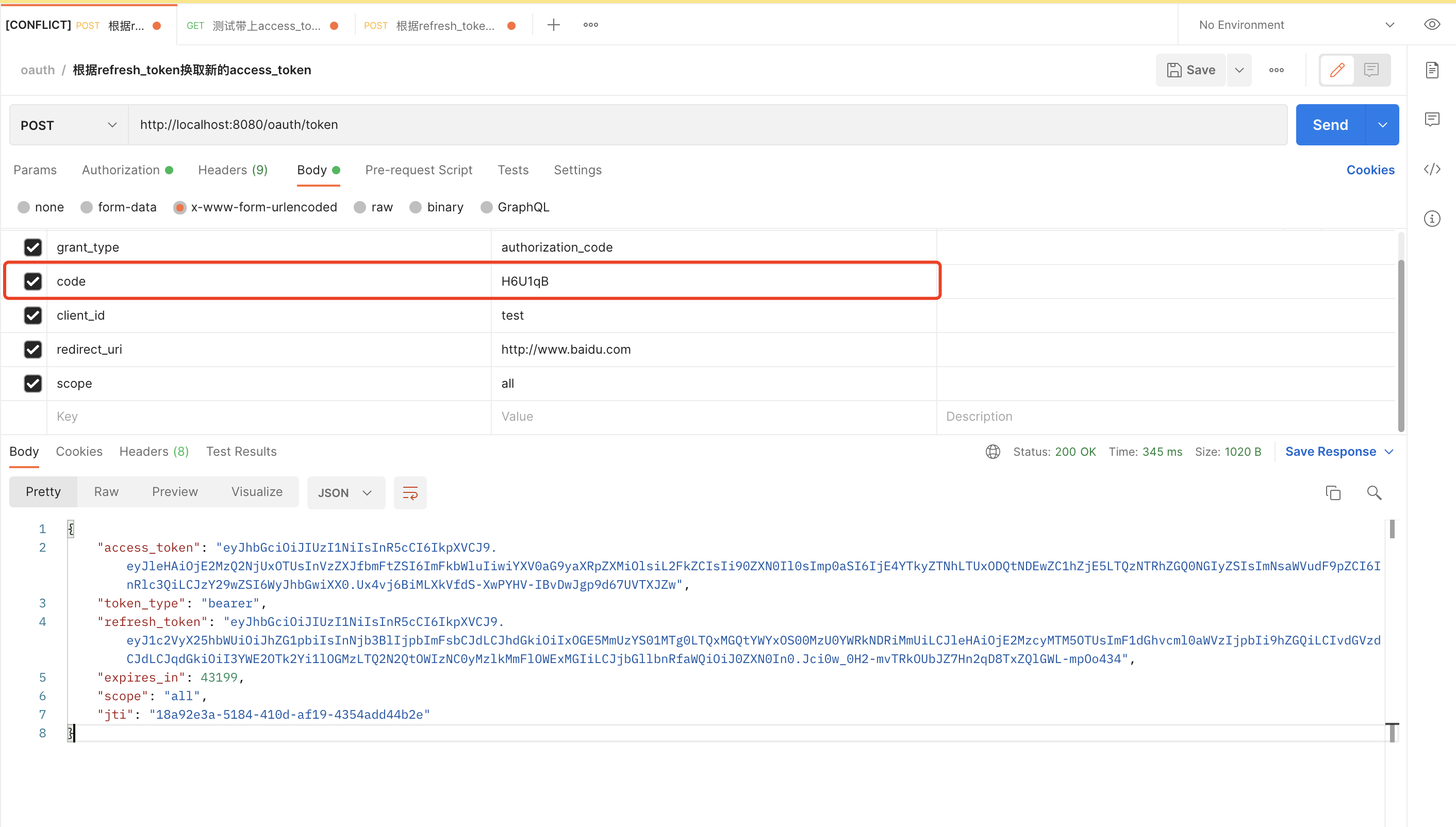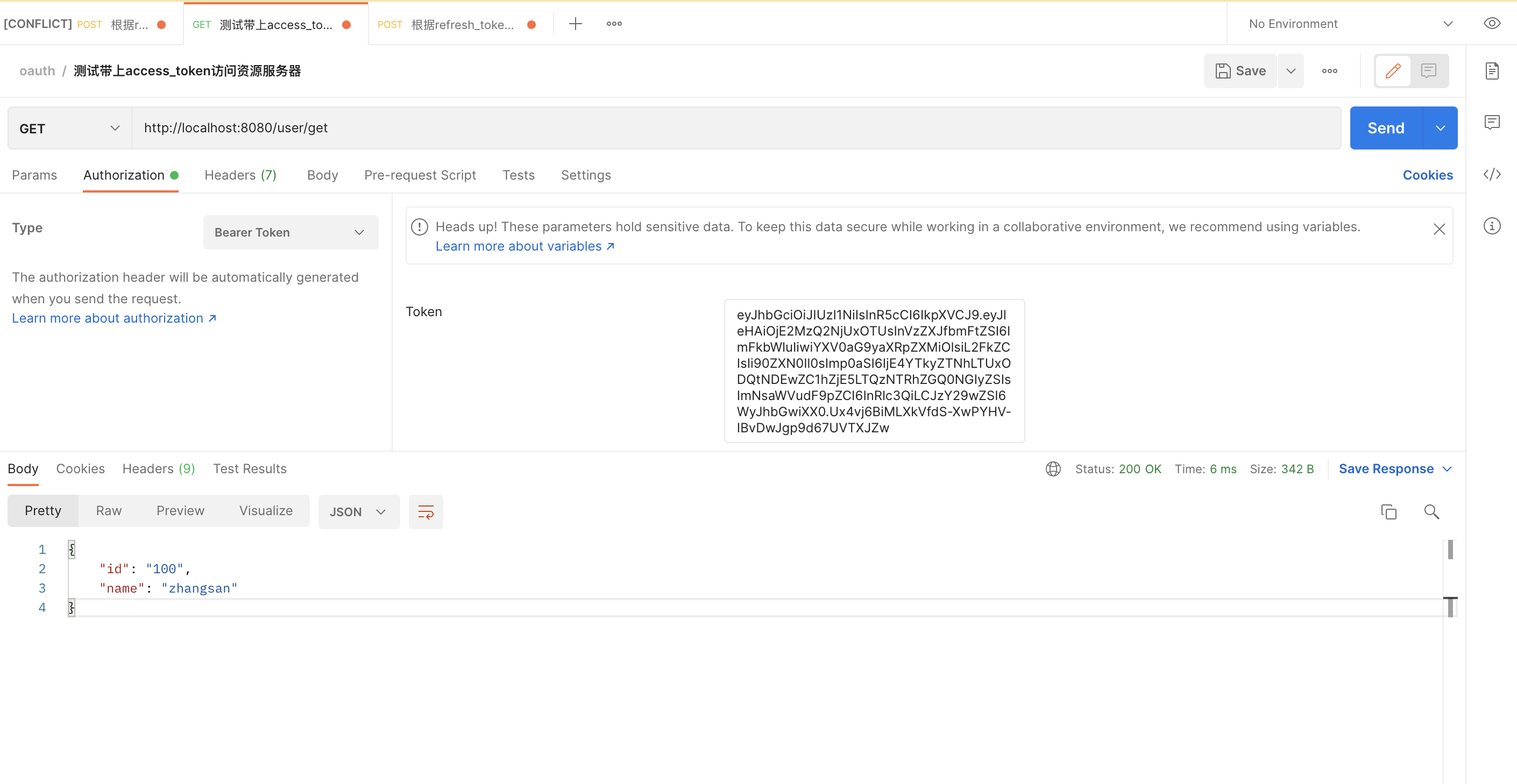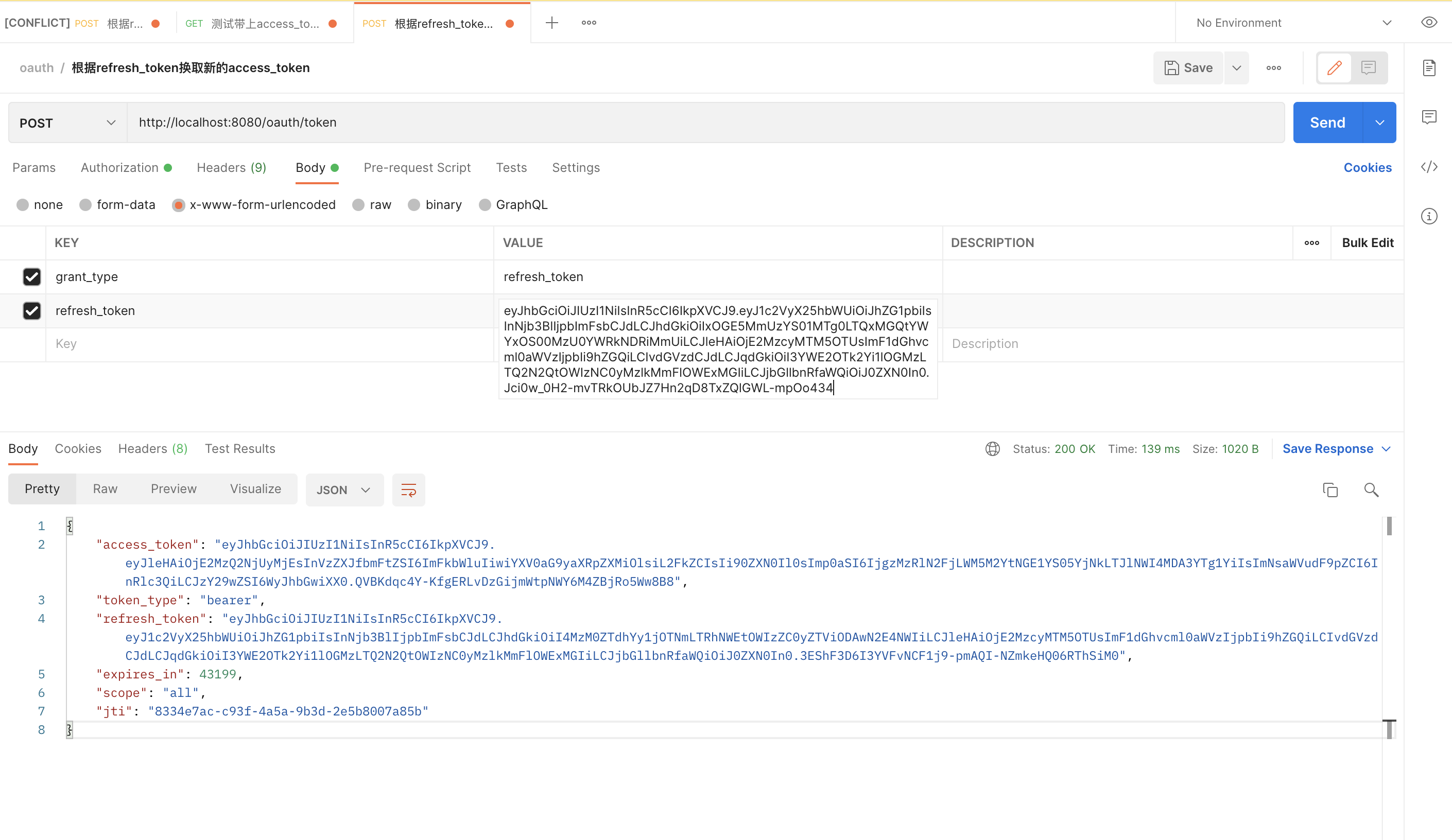(1). 概述
Oauth2一直都比较流行,在这里稍微的拿个小小的Demo来入门,后面,会对源码进行剖析.
(2). 项目结构
“spring-security-oauth-example.zip下载”
lixin@lixin Workspace % tree spring-security-oauth-example
spring-security-oauth-example
├── pom.xml
├── src
│ ├── main
│ │ ├── java
│ │ │ └── help
│ │ │ └── lixin
│ │ │ └── oauth
│ │ │ ├── Application.java
│ │ │ ├── config
│ │ │ │ ├── AuthorizeConfig.java
│ │ │ │ ├── JwtTokenStoreConfig.java
│ │ │ │ ├── ResourceConfig.java
│ │ │ │ └── SecurityConfig.java
│ │ │ ├── controller
│ │ │ │ └── UserController.java
│ │ │ └── service
│ │ │ └── UserService.java
│ │ └── resources
│ └── test
│ └── java
└── target
(3). UserService
package help.lixin.oauth.service;
import org.springframework.beans.factory.annotation.Autowired;
import org.springframework.security.core.userdetails.User;
import org.springframework.security.core.userdetails.UserDetails;
import org.springframework.security.core.userdetails.UserDetailsService;
import org.springframework.security.core.userdetails.UsernameNotFoundException;
import org.springframework.security.crypto.password.PasswordEncoder;
import org.springframework.stereotype.Service;
@Service
public class UserService implements UserDetailsService {
@Autowired
private PasswordEncoder passwordEncoder;
public void setPasswordEncoder(PasswordEncoder passwordEncoder) {
this.passwordEncoder = passwordEncoder;
}
public PasswordEncoder getPasswordEncoder() {
return passwordEncoder;
}
@Override
public UserDetails loadUserByUsername(String username) throws UsernameNotFoundException {
// 登录的用户和密码
return User.withUsername("admin")
.password(passwordEncoder.encode("111111"))
.authorities("/add", "/test")
.build();
}
}
(4). SecurityConfig
package help.lixin.oauth.config;
import org.springframework.context.annotation.Bean;
import org.springframework.context.annotation.Configuration;
import org.springframework.security.config.annotation.web.builders.HttpSecurity;
import org.springframework.security.config.annotation.web.configuration.EnableWebSecurity;
import org.springframework.security.config.annotation.web.configuration.WebSecurityConfigurerAdapter;
import org.springframework.security.crypto.bcrypt.BCryptPasswordEncoder;
import org.springframework.security.crypto.password.PasswordEncoder;
@Configuration
@EnableWebSecurity
public class SecurityConfig extends WebSecurityConfigurerAdapter {
@Bean
public PasswordEncoder passwordEncoder() {
return new BCryptPasswordEncoder();
}
@Override
protected void configure(HttpSecurity http) throws Exception {
// 关闭csrf防护
http.csrf().disable();
http.authorizeRequests()
// 允许部份请求可以访问
.antMatchers("/oauth/**", "/login/**", "/logout/**").permitAll()
// 其余所有的请求,都要认证后才能访问
.anyRequest().authenticated()
.and()
// 允许表单登录的访问
.formLogin().permitAll();
}
}
(5). AuthorizeConfig
package help.lixin.oauth.config;
import help.lixin.oauth.service.UserService;
import org.springframework.beans.factory.annotation.Autowired;
import org.springframework.context.annotation.Configuration;
import org.springframework.security.crypto.password.PasswordEncoder;
import org.springframework.security.oauth2.config.annotation.configurers.ClientDetailsServiceConfigurer;
import org.springframework.security.oauth2.config.annotation.web.configuration.AuthorizationServerConfigurerAdapter;
import org.springframework.security.oauth2.config.annotation.web.configuration.EnableAuthorizationServer;
import org.springframework.security.oauth2.config.annotation.web.configurers.AuthorizationServerEndpointsConfigurer;
import org.springframework.security.oauth2.provider.token.store.JwtAccessTokenConverter;
import org.springframework.security.oauth2.provider.token.store.JwtTokenStore;
/**
* 授权服务器配置
*/
@Configuration
// 1. 开启Authorization注解
@EnableAuthorizationServer
public class AuthorizeConfig extends AuthorizationServerConfigurerAdapter {
@Autowired
private PasswordEncoder passwordEncoder;
@Autowired
private UserService userService;
@Autowired
private JwtTokenStore jwtTokenStore;
@Autowired
private JwtAccessTokenConverter jwtAccessTokenConverter;
@Override
public void configure(AuthorizationServerEndpointsConfigurer endpoints) throws Exception {
// 密码模式下,需要配置:AuthenticationManager和UserDetailsService
endpoints
.userDetailsService(userService)
.tokenStore(jwtTokenStore)
.accessTokenConverter(jwtAccessTokenConverter);
}
@Override
public void configure(ClientDetailsServiceConfigurer clients) throws Exception {
// 暂时放在内存里
clients.inMemory()
.withClient("test")
.secret(passwordEncoder.encode("test"))
// .accessTokenValiditySeconds(3600)
.redirectUris("http://www.baidu.com")
.scopes("all")
// 授权码模式/以及refresh_token
.authorizedGrantTypes("authorization_code", "refresh_token");
}
}
(6). ResourceConfig
package help.lixin.oauth.config;
import org.springframework.context.annotation.Configuration;
import org.springframework.security.config.annotation.web.builders.HttpSecurity;
import org.springframework.security.oauth2.config.annotation.web.configuration.EnableResourceServer;
import org.springframework.security.oauth2.config.annotation.web.configuration.ResourceServerConfigurerAdapter;
/**
* 资源服务器配置
*/
@Configuration
// 1. 开启注解(@EnableResourceServer)
@EnableResourceServer
public class ResourceConfig extends ResourceServerConfigurerAdapter {
@Override
public void configure(HttpSecurity http) throws Exception {
http.authorizeRequests()
.anyRequest().authenticated()
.and()
.requestMatchers().antMatchers("/user/**");
}
}
(7). JwtTokenStoreConfig
package help.lixin.oauth.config;
import org.springframework.context.annotation.Bean;
import org.springframework.context.annotation.Configuration;
import org.springframework.security.oauth2.provider.token.store.JwtAccessTokenConverter;
import org.springframework.security.oauth2.provider.token.store.JwtTokenStore;
/**
* jwt token配置
*/
@Configuration
public class JwtTokenStoreConfig {
@Bean
public JwtAccessTokenConverter jwtAccessTokenConverter() {
JwtAccessTokenConverter jwtAccessTokenConverter = new JwtAccessTokenConverter();
// 配置jwt使用的密钥
jwtAccessTokenConverter.setSigningKey("hello");
return jwtAccessTokenConverter;
}
@Bean
public JwtTokenStore jwtTokenStore(JwtAccessTokenConverter jwtAccessTokenConverter) {
return new JwtTokenStore(jwtAccessTokenConverter);
}
}
(8). UserController
package help.lixin.oauth.controller;
import org.springframework.security.core.Authentication;
import org.springframework.web.bind.annotation.GetMapping;
import org.springframework.web.bind.annotation.RequestMapping;
import org.springframework.web.bind.annotation.RestController;
import java.io.Serializable;
import java.util.Objects;
@RestController
@RequestMapping("/user")
public class UserController {
/**
* 获取当前用户
*
* @param authentication
* @return
*/
@GetMapping("/get")
public User user(Authentication authentication) {
Object principal = authentication.getPrincipal();
User user = new User();
user.setId("100");
user.setName("zhangsan");
return user;
}
}
class User implements Serializable {
private String id;
private String name;
public String getId() {
return id;
}
public void setId(String id) {
this.id = id;
}
public String getName() {
return name;
}
public void setName(String name) {
this.name = name;
}
@Override
public boolean equals(Object o) {
if (this == o) return true;
if (o == null || getClass() != o.getClass()) return false;
User user = (User) o;
return Objects.equals(id, user.id) && Objects.equals(name, user.name);
}
@Override
public int hashCode() {
return Objects.hash(id, name);
}
@Override
public String toString() {
return "User{" +
"id='" + id + '\'' +
", name='" + name + '\'' +
'}';
}
}
(9).Application
package help.lixin.oauth;
import org.springframework.boot.SpringApplication;
import org.springframework.boot.autoconfigure.SpringBootApplication;
@SpringBootApplication
public class Application {
public static void main(String[] args) {
SpringApplication.run(Application.class, args);
}
}
(10). 引导用户至登录页面
http://localhost:8080/oauth/authorize?response_type=code&client_id=test&redirect_uri=http://www.baidu.com&scope=all

(12). 用户授权登录

(13). 重定向到客户端,并返回code

(14). 通过code换access_token
设置client/secret/code.


(14). 使用access_token请求资源服务器

(15). 使用refresh_token重新生成access_token

